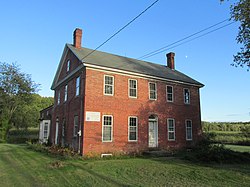
This is intended to be a complete list of the properties and districts on the National Register of Historic Places in Fairfield County, Connecticut, United States. The locations of National Register properties and districts for which the latitude and longitude coordinates are included below, may be seen in an online map.
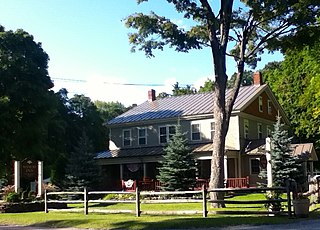
The Waybury Inn is an inn at 457 East Main Street in Middlebury, Vermont, United States. The inn was built in 1810, and is one of the oldest operating traveler's accommodations in the state. It was listed on the National Register of Historic Places in 1983. It is well known for its use in exterior shots of the Newhart television series.

The Snead Building located at 815 W. Market St. is a multi-use facility housing two working glass studios : a Walk-In Workshop and tours by appointment.

The Pitkin Glassworks Ruin is a historic industrial archaeological site at the junction of Parker and Putnam Streets in Manchester, Connecticut. It contains the remains of one of the oldest glass factories in New England, established in 1783. It was listed on the National Register of Historic Places in 1979.
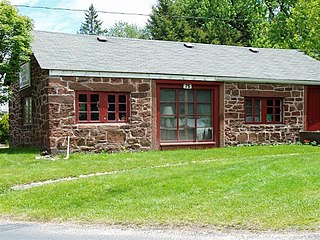
The Somersville Historic District encompasses the historic components of the mill village of Somersville in western Somers, Connecticut, United States. The district is centered on a mill complex on the Scantic River, which divides the district. The most significant years of development were between about 1835 and 1935, although the area has a history dating to the 1760s. The district was listed on the National Register of Historic Places in 1995. The Mill itself has since burned down and as of October 2018 is currently open field, although the canal structure remains in place.

The Amelung House and Glassworks is a historic home located at Urbana, Frederick County, Maryland, United States. It is a two-story, late-Georgian brick home on a stone foundation built about 1785. The property once had the New Bremen glassworks built by Johann Friedrich Amelung after he came to Maryland in 1784; no above-ground remains of the factory remain. Fine examples of New Bremen glass work may be seen at the Metropolitan Museum of Art in New York City; the Corning Museum of Glass in Corning, New York; and Winterthur Museum in Winterthur, Delaware.

Goshen Historic District is a historic district encompassing the town center village of Goshen, Connecticut. Centered at the junction of Connecticut Routes 4 and 63, the village developed historically as a rural crossroads of two turnpikes, and has retained its rural character. It is dominated by residential architecture from the first half of the 19th century, and includes churches, a store, and the town's former 1895 town hall. It was listed on the National Register of Historic Places in 1982.
The Albany Glassworks Site is an archeological site in Guilderland, Albany County, New York. Approximately 2 acres (0.81 ha) in size, it was listed on the National Register of Historic Places in 1980.
This is a list of the properties and historic districts in Stamford, Connecticut that are listed on the National Register of Historic Places. The locations of National Register properties and districts for which the latitude and longitude coordinates are included below, may be seen in a Google map.
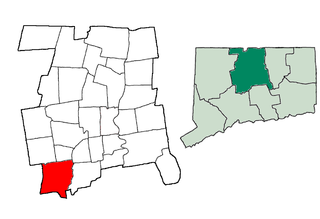
This is a list of the National Register of Historic Places listings in Southington, Connecticut.
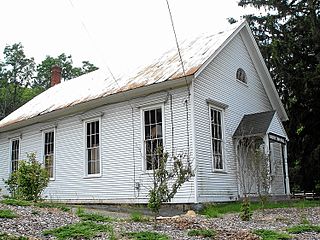
The Andover Center Historic District encompasses the historic town center of Andover, Connecticut. Centered on the junction of Hebron Road with Center Street and Cider Mill Road, the district includes houses dating to the town's early history, civic buildings including a library and former town hall, and the town's first cemetery. The district was listed on the National Register of Historic Places in 2003.

The Prospect Avenue Historic District encompasses a predominantly residential area in western Hartford and eastern West Hartford, Connecticut. The 300-acre (120 ha) historic district extends along Prospect Avenue from Albany Avenue to Fern Street, including most of the area between those streets and the Park River to the east, and Sycamore Street and Sycamore Lane to the west. The district includes 240 contributing buildings and 48 non-contributing buildings, most of them residences built between 1880 and 1930. The district was listed on the National Register of Historic Places in 1985.

Brigham's Tavern is a historic house and traveller's accommodation at 12 Boston Turnpike in Coventry, Connecticut. With a construction history dating to the early 18th century, it is one of the town's oldest buildings, and is historically associated with George Washington, who stopped here for a meal in 1789. Now a private residence, it was listed on the National Register of Historic Places in 1982.

The Loomis-Pomeroy House is a historic house at 1747 Boston Turnpike in Coventry, Connecticut. Built about 1833, it is a fine local example of transitional Federal-Greek Revival architecture, with important family associations in local history. The house was listed on the National Register of Historic Places in 1994.

The Capron-Phillips House is a historic house located at 1129 Main Street in the South Coventry village of Coventry, Connecticut. Built about 1864, it is a well-preserved example of Italianate architecture, retaining significant interior and exterior features. It also served as Coventry's post office and drug store for many years. It was listed on the National Register of Historic Places in 1982, and is a contributing property to the South Coventry Historic District.
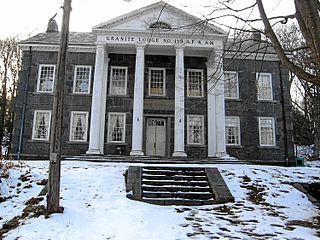
The Haddam Center Historic District is a 267-acre (108 ha) historic district encompassing the institutional and residential center of the town of Haddam, Connecticut that was listed on the National Register of Historic Places in 1989 as a result of efforts by the Haddam Historical Society.

The New England Glassworks was a short-lived glass-making factory located in Temple, New Hampshire in the 1780s, and one of the first glassworks in the United States. Founded in 1780 by Robert Hewes, a Boston-based businessman, the glassworks employed Hessian deserters from the British forces of the American Revolutionary War. The glassworks was established in 1780 and failed due to a lack of financing in 1783. Its abandoned site was excavated in the 1970s, and is now listed on the National Register of Historic Places.

The Jarvesville Historic District of Sandwich, Massachusetts is a predominantly residential historic district centered on the site of the former Boston and Sandwich Glass Company factory. It is located north and east of Sandwich Center. Although the area has buildings that date to the middle of the 18th century, most of the district's more than 200 contributing properties are residences built between 1825 and 1860, when the glass company was at its height. These houses are predominantly Cape and Greek Revival in character, and are modest one- and two-family buildings that originally housed glass factory workers.
The Museum of Connecticut Glass is a museum about 19th Century glass Coventry, Connecticut, founded on February 12, 1994. It is located in the Captain John Turner House (1813)
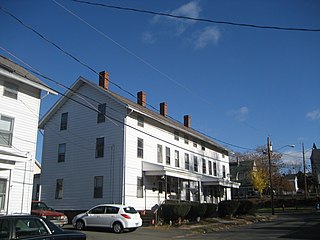
The Bigelow-Hartford Carpet Mills Historic District encompasses a company-built factory and residential area in the Thompsonville area of Enfield, Connecticut. In addition to the former factory buildings of the Bigelow-Hartford Carpet Mills, it includes more than 150 housing units built by the company between about 1830 and 1920. It is roughly bounded on the north by Lafayette Street and Alden Avenue, the east by Hartford Avenue and Lincoln Street, the south by High Street, and the west by River Street. It was listed on the National Register of Historic Places in 1994.





